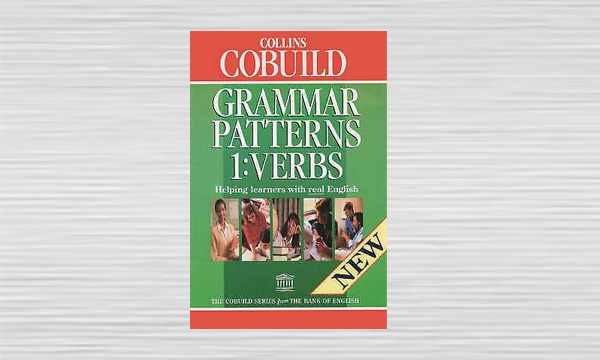Gill Francis (she later used the spelling Jyl) was one of the pioneering team who worked on the Collins Cobuild English Dictionary (CCED), published in 1995, and led a small team that compiled the Grammar Pattern series published in 1996 and 1998. In this she was responsible for extending the Cobuild approach beyond vocabulary, thereby breaking down the artificial barrier between lexis and grammar, especially in regard to the teaching of English.
Jyl’s most obvious contribution to CCED was the development of a unique notation for recording grammatical information. The observed behaviour of words is indicated by a ‘pattern’: a sequence of elements. The system uses terminology such as ‘noun’ and ‘that-clause’, but it avoids analytic terms such as ‘indirect object’ or ‘adjunct’. The result is a novel, transparent notation, easily interpreted by learners and teachers. The system is also comprehensive, in that all words, whatever their word-class, are described in the same way. For example, the sense of the preposition ‘to’ in expressions such as ‘give something to someone’ is coded as ‘v n PREP n’. The word classes themselves are defined in terms of their grammatical environment. A preposition, for example, is defined as ‘followed by a noun group or a present participle’. This means that each dictionary entry, coded for its word class and patterns, gives full information about how to use the word.
Another advantage is that the system shows the relation between word meaning and phraseology. For example, the various senses of ‘reflect’ are distinguished by the patterns they are used with: ‘reflect off a surface’ – ‘V prep’; ‘reflect that something is the case’ – ‘V that’; ‘reflect on something’ – ‘V on n’; ‘reflect an attitude’ – ‘V n’; ‘an action reflects well or badly on someone’ – ‘V adv on n’. The metaphorical sense of ‘ladder’, unlike the literal sense, typically occurs with a pre- or post-modifier (‘the ladder of success’ or ‘the social ladder’). (In a typically bold innovation, Jyl coined the term ‘with supplement’ to capture this range of behaviours.) Similarly, the non-literal senses of ‘face’ have specific patterns: ‘be faced with something bad’ – ‘be V-ed with n’; ‘the face of British politics’ – ‘the N of n’. The flexibility of the pattern system enables this unity of form and meaning to be recorded.
Thus, the grammar pattern approach devised by Jyl Francis became a simple yet powerful resource in dictionary entries. It shows learners, in detail, how to use each word. It also contributes to theories of lexico-grammar that focus on the intersection of form and meaning.
By the end of the compilation of CCED, a database existed of the grammar patterns found with each sense of each word in the dictionary. A logical next step was to reverse the process, as it were. Now that we knew which patterns went with which words, it was possible to list all the words that had been identified as being used with each pattern. This was the starting point for Jyl’s next project: the Collins Cobuild Grammar Patterns books. Volume 1: Verbs was published in 1996, and volume 2: Nouns and Adjectives was published in 1998. The scope of these books showed that the ‘grammar patterns’ associated with these major word classes are numerous but by no means infinite. The books encompass 93 main verb patterns, 63 noun patterns, and 49 adjective patterns. For each pattern, a number of ‘meaning groups’ are identified, with each group containing words that share an aspect of meaning. For example, the 322 nouns listed in the ‘N that’ pattern are divided into 6 groups: (i) words connected with speaking or writing: ‘assertion’, ‘explanation’, ‘promise’, ‘suggestion’ etc; (ii) words connected with thought: ‘belief’, ‘fear’, ‘reasoning’, ‘wish’ etc; (iii) words connected with emotion: ‘anger’, ‘disappointment’, ‘happiness’, ‘sorrow’ etc; (iv) words connected with evidence: ‘confirmation’, ‘indication’, ‘sign’ etc; (v) words connected with probability: ‘chance’, ‘likelihood’, ‘possibility’ etc; (vi) other nouns that do not fit into the above groups: ‘basis’, ‘convention’, ‘discovery’, ‘problem’, ‘tradition’ and 37 others.
The grammar pattern books are remarkable in their comprehensive level of detail, a standard that Jyl as team leader rigorously upheld. As well as the main patterns mentioned above, more specific patterns are also noted. For example, information about the main pattern ‘V n in n’ is supplemented by the listing of more specific patterns used with only a few verbs each: ‘V n in num’ (‘We numbered our friends in the thousands.’); ‘V n in fraction’ (‘Split the apple in half.’); ‘V n ord in n’ (‘They ranked him fourth in the list.’). With a very few exceptions, every word associated with each pattern is listed, even though this requires a ‘miscellaneous’ group alongside the meaning groups. (The exceptions are the patterns used with many thousands of verbs or nouns: ‘V’, ‘V n’, ‘N of n’. To prevent the books running to thousands of pages, only the most frequent verbs and nouns are included.) The descriptors of the meaning groups also contain considerable detail. For example, the meaning group in the pattern ‘V n of n’ that includes examples such as ‘acquit/convict/suspect someone of a crime’ notes that the noun group following the verb indicates the person accused of the crime and the prepositional phrase indicates the crime. Although there is no formal mapping of meaning element to pattern element, the information needed make that mapping is recorded. Of necessity, the books are a snapshot of English – the information is drawn from a specific corpus at a specific time – but they remain the most comprehensive account available of the lexical grammar of English. This makes them of value to researchers in related approaches, such as Construction Grammar and FrameNet.
Again because of Jyl’s leadership, the books demonstrate an impressive level of insight and descriptive accuracy that often revises accepted accounts of English grammar. For example, the chapter on Ergative Verbs in the first Grammar Patterns volume records the conventional alternation between intransitive and transitive forms, as in: ‘The window broke’ – ‘V’ and ‘John broke the window’ – ‘V n’. It goes beyond that to record five other symmetrical combinations, such as ‘V as adj’ and ‘V n as n’, as in ‘That score counts as successful’ and ‘We count that score as successful’. It also, breaking with convention, lists four ‘asymmetrical’ combinations, such as ‘V prep’ and ‘V n’, as in ‘Smoke puffed out of the chimney’ and ‘The chimney puffed smoke’, or ‘V adv’ and ‘V n’, as in ‘The carpet cleans easily’ and ‘We cleaned the carpet’ (but not ‘*The carpet cleaned’).
About 20 years after the original publication of the Grammar Pattern books, HarperCollins re-launched the series as a web-site, making the inventory of patterns, the meaning groups and lists, and the examples, freely available and linking them to the on-line Cobuild dictionary. Jyl played a crucial role in revising and updating the material, reviewing it in particular for changes in English usage that had taken place in the intervening years.
An important aspect of the Cobuild publications is that they demonstrate the synergy between academic research and practical application. On the one hand they are an accurate and accessible resource for language learning. On the other hand, they are the outcome of many person-years of original corpus research. Jyl Francis contributed to both these aspects. She was the cleverest person I have ever known, and her ability to derive information from a corpus – an art as well as a science – was unparalleled. She contributed a wealth of evidence to usage-based theories of language. At the same time she addressed the student directly. Her contribution to pedagogic reference resources in English was unique.
By Susan Hunston, University of Birmingham




collins_dictionary_official
The home of living language. #wotd #wordlovers #collinsdictionary
Read our word of the week definitions and blog posts: